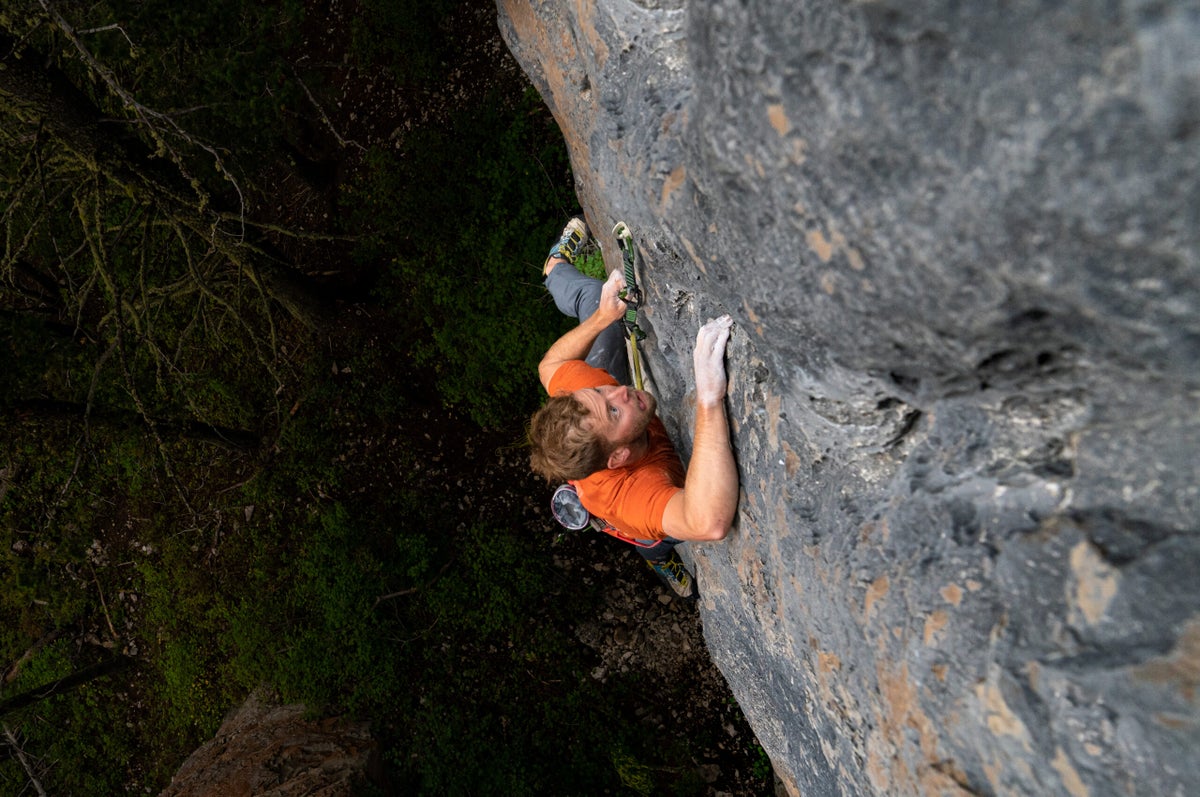“], “filter”: { “nextExceptions”: “img, figure, blockquote, div”, “nextContainsExceptions”: “img, figure, blockquote, a.btn, a.o-button”} }”>
Heading out the door? Read this article on the new Outside+ app available now on iOS devices for members!
>”,”name”:”in-content-cta”,”type”:”link”}}”>Download the app.
In our third decade, we start losing mass in skeletal muscles, and in our forties, the process accelerates—we may lose as much as 10 to 20 percent. Climbers may note this less because the decline is greater in the lower body than in the upper. But still, it’s happening. Most of the muscle lost is fast-twitch, so power will drop first. But there is some good news: Endurance persists. Read on to sidestep nature.
Muscle Protein Breakdown Vs. Muscle Protein Synthesis
Muscle is constantly being broken down (muscle protein breakdown; MPB) and rebuilt (muscle protein synthesis; MPS). Muscle loss occurs when the balance tips toward breakdown. How is muscle protein built? The accepted wisdom is that you need a lot of protein, especially animal protein. Actually, our bodies can synthesize most amino acids—the building blocks of protein—from smaller constituents in most foods. We do need to get some amino acids—essential amino acids (EAA)—from diet. The EAAs from animal sources match our needs most closely, but you can also mix and match plants. Then, genetic instructions are followed for building specific types of muscle proteins (e.g., fast- and slow-twitch fibers).
When you work your muscles, they burn fuel to contract—much like a car burns gas. Both processes also produce pollutants. The damage to the muscle cell stimulates built-in repair programs that build and strengthen the muscle. The catch is that you have to have amino acids handy for the buildup, though if you consume too many, they get stored as fat (see “Eat to Build Muscle”).
In active individuals like climbers, what changes with age is the ability to build muscle after consuming protein. In what physiologists call anabolic resistance, our muscle cells get worse at pulling protein building blocks out of the blood and using them. No one is really sure why, but it seems to be due to our muscle stem cells deteriorating as they age. Meanwhile, if you don’t use your muscles, MPS drops off so much that this decline alone explains age-related loss.
To maintain muscle mass, we need to maximize MPS and minimize MPB.
Eat to Build Muscle
The muscle-loss part of the equation accelerates around age 50. Before that, your muscle cells are still pretty good at using EAAs. Recent findings suggest that individuals <50 should be eating 0.7–0.8 grams of protein per kilo of body weight per day, while the >50 crowd should aim for 1–1.3 grams. This translates to 60 grams of protein for a 150-pound guy in his 40s, and the same if you’re a 115-pound sexagenarian like me. (See “Tips.”)
Also read: You Can Get Stronger Than Ever in your 40s, 50s and 60s. Here’s How
An easily digestible protein such as whey, found in many protein powders, can further stimulate MPS. The most important EAA for jumpstarting MPS is leucine. Leucine is an initiator for a chain of events that culminates in protein synthesis. However, the stronger that signal, the greater the chance of stimulating cancer cells. Research has shown that high protein intake—more than 10 percent of daily calories from meat and dairy, but not plants—earlier in life (approx. 50 and younger) resulted in big increases in cancer and diabetes later.
Move to Build Muscle
Moderate to severe exercise will increase both MPB and MPS. Eating a high-protein meal post-workout will increase MPS but decrease MPB. In both young (20 years) and older (50 years) athletes, exercise followed by 20 grams of good-quality protein increased MPS compared to exercise without protein intake afterward. More good news: Resistance exercise—weight training or climbing—can enhance the MPS response to protein consumption for days after the workout. Translation: You likely don’t need to eat that protein immediately.
Also read: Climb Harder By Being Weaker … And Flexible
Tips
- Dissolve 5 grams of leucine powder in your water bottle and sip during your workout (try LiveLong, Infinite Labs, or Evogen)
- Eat 20 grams of protein after working out. Protein powders make it easy but other options include:
- Chicken or turkey sandwich or wrap with 4 oz. meat (4–6 slices)
- Canned tuna (½ cup)
- Tofu (½ cup)
- Almonds or almond butter (5 oz.)
- 3 eggs
- Just climbing or climbing-specific training 3–4 days will maximize MPS benefits.
Also read: Struggling to Maintain Muscle Mass? Here’s What You Need to Know About Supplemental Strength Training.
Acronyms
- EAA: essential amino acid
- MPB: muscle protein breakdown
- MPS: muscle protein synthesis
Beth Bennett has climbed for over 40 years, doing many FAs and FFAs in the 1970s; in the mid-1980s, she received her PhD in genetics. Nutritional biochemistry is a longstanding interest of hers.
This training article first appeared in Rock and Ice.

Sarah Carter is a health and wellness expert residing in the UK. With a background in healthcare, she offers evidence-based advice on fitness, nutrition, and mental well-being, promoting healthier living for readers.








